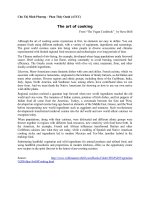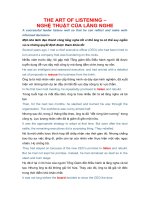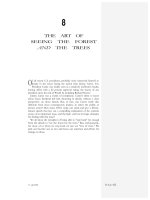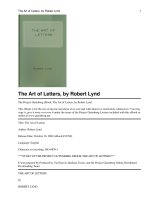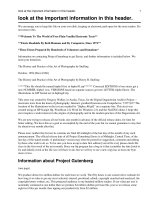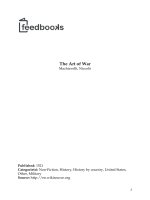Solution the art of writing reasonable organic reaction mechanisms
Bạn đang xem bản rút gọn của tài liệu. Xem và tải ngay bản đầy đủ của tài liệu tại đây (2.33 MB, 217 trang )
1
Answers To Chapter 1 In-Chapter Problems.
1.1. The resonance structure on the right is better because every atom has its octet.
1.2.
O–
CH2+
O
C
NMe2
O
C
O
NMe2
NMe2
NMe2
N
CH2
CH2
CH2
NMe2
N
N
H3C
NMe2
N
H3C
N CH2
H3C
N
CH2
H3C
the second structure is hopelessly strained
O
O
N
Chapter 1
2
1.3.
sp2
sp
sp
O sp
2
sp2
O
N
sp2
sp2
sp3
O–
Ph
sp2
sp2
sp2
B
F
H3C
Ph
O
H2C
F
H
sp3
CH3
H3C
sp3
sp3
CH3
sp3
H
sp
sp2
CH3
CH3
sp3
sp2
sp3
all sp2
all sp2
F
N
sp3
CH3
sp2
H
H
1.4. The O atom in furan has sp2 hybridization. One lone pair resides in the p orbital and is used in
resonance; the other resides in an sp2 orbital and is not used in resonance.
1.5.
(a) No by-products. C(1–3) and C(6–9) are the keys to numbering.
1
4
6
7
10
3
2
5 12
OH
11
13
9
H+, H2O
O
1
7
O10
3
12
4
2
8
Ph
9
8
O
5
Ph
6
11 13
H
(b) After numbering the major product, C6 and Br25 are left over, so make a bond between them and call
it the by-product.
13
12
H
20
10
HN 11
1
9
Br
O
16
8
17
18
7
4
5 OMe6
22
OMe
23
24
15
15
21
19
2
3
14
24
25
Br
Br
Br 16
14
13
1
12
11
9
Br
N
10
2
3
17
21O
20
18
6
25
Me
Br
8 19
4
7
OMe
O5
1.6. (a) Make C4–O12, C6–C11, C9–O12. Break C4–C6, C9–C11, C11–O12.
(b) Make C8–N10, C9–C13, C12–Br24. Break O5–C6, C8–C9.
1.7. PhC≡CH is much more acidic than BuC≡CH. Because the pKb of HO– is 15, PhC≡CH has a pKa ≤
23 and BuC≡CH has pKa > 23.
Chapter 1
3
1.8. The OH is more acidic (pKa ≈ 17) than the C α to the ketone (pKa ≈ 20). Because the by-product of
the reaction is H2O, there is no need to break the O–H bond to get to product, but the C–H bond α to the
ketone must be broken.
Chapter 1
4
Answers To Chapter 1 End-Of-Chapter Problems.
1. (a) Both N and O in amides have lone pairs that can react with electrophiles. When the O reacts with
an electrophile E+, a product is obtained for which two good resonance structures can be drawn. When
the N reacts, only one good resonance structure can be drawn for the product.
E
reaction on O
R
E
O
N
R
R
R
O
O
reaction on N
N
R
R
N
E
R
R
R
(b) Esters are lower in energy than ketones because of resonance stabilization from the O atom. Upon
addition of a nucleophile to either an ester or a ketone, a tetrahedral intermediate is obtained for which
resonance is not nearly as important, and therefore the tetrahedral product from the ester is nearly the same
energy as the tetrahedral product from the ketone. As a result it costs more energy to add a nucleophile to
an ester than it does to add one to a ketone.
(c) Exactly the same argument as in (b) can be applied to the acidity of acyl chlorides versus the acidity of
esters. Note that Cl and O have the same electronegativity, so the difference in acidity between acyl
chlorides and esters cannot be due to inductive effects and must be due to resonance effects.
(d) A resonance structure can be drawn for 1 in which charge is separated. Normally a charge-separated
structure would be a minor contributor, but in this case the two rings are made aromatic, so it is much
more important than normal.
(e) The difference between 3 and 4 is that the former is cyclic. Loss of an acidic H from the γ C of 3
gives a structure for which an aromatic resonance structure can be drawn. This is not true of 4.
H3C
H
O
O
–H
+
H3C
H3C
O
O
O
O
(f) Both imidazole and pyridine are aromatic compounds. The lone pair of the H-bearing N in imidazole
is required to maintain aromaticity, so the other N, which has its lone pair in an sp2 orbital that is perpendicular to the aromatic system, is the basic one. Protonation of this N gives a compound for which two
Chapter 1
5
equally good aromatic resonance structures can be drawn. By contrast, protonation of pyridine gives an
aromatic compound for which only one good resonance structure can be drawn.
H
N
H
H
N
+
N
H
N
HN
HN
(g) The C=C π bonds of simple hydrocarbons are usually nucleophilic, not electrophilic. However, when
a nucleophile attacks the exocyclic C atom of the nonaromatic compound fulvene, the electrons from the
C=C π bond go to the endocyclic C and make the ring aromatic.
–
Nu
Nu
non-aromatic
aromatic
(h) The tautomer of 2,4-cyclohexadienone, a nonaromatic compound, is phenol, an aromatic compound.
+ –
(i) Carbonyl groups C=O have an important resonance contributor C–O. In cyclopentadienone, this
resonance contributor is antiaromatic.
[Common error alert: Many cume points have been lost over the years when graduate students used
cyclohexadienone or cyclopentadienone as a starting material in a synthesis problem!]
(j) PhOH is considerably more acidic than EtOH (pKa= 10 vs. 17) because of resonance stabilization of
the conjugate base in the former. S is larger than O, so the S(p)–C(p) overlap in PhS– is much smaller
than the O(p)–C(p) overlap in PhO–. The reduced overlap in PhS– leads to reduced resonance stabilization, so the presence of a Ph ring makes less of a difference for the acidity of RSH than it does for the
acidity of ROH.
(k) Attack of an electrophile E+ on C2 gives a carbocation for which three good resonance structures can
be drawn. Attack of an electrophile E+ on C3 gives a carbocation for which only two good resonance
structures can be drawn.
H
H
H
2
E+
E
H
O
O
H
H
H
H
E
H
O
H
H
H
E
H
O
H
H
H
Chapter 1
H
H
E
H
3
+
E
O
H
6
H
H
E
O
H
H
O
H
H
H
H
2. (a)
O
O
inductive electron-withdrawing
effect of F is greater than Cl
Cl3C
F3C
OH
OH
(b)
N
H2
In general, AH + is more
acidic than AH
N
H
(c)
O
EtO
O
O
CH3
H3C
O
CH3
Ketones are more
acidic than esters
(d)
Deprotonation of 5-membered
ring gives aromatic anion;
deprotonation of 7-membered
ring gives anti-aromatic anion.
(e)
NH
NH2
The N(sp2) lone pair derived from deprotonation
of pyridine is in lower energy orbital, hence more
stable, than the N(sp3) lone pair derived from
deprotonation of piperidine.
Chapter 1
7
(f)
PH2
Acidity increases as you move down a
column in the periodic table due to
increasing atomic size and hence worse
overlap in the A–H bond
NH2
(g)
CO2Et
The anion of phenylacetate
is stabilized by resonance
into the phenyl ring.
CO2Et
(h)
EtO2C
CO2Et
EtO2C
CO2Et
Anions of 1,3-dicarbonyl
compounds are stabilized
by resonance into two
carbonyl groups
(i)
The anion of 4-nitrophenol is stabilized
by resonance directly into the nitro
group. The anion of 3-nitrophenol can't
do this. Draw resonance structures to
convince yourself of this.
OH
O2N
O2N
OH
–
O
N
–
O
O
–
N
–
O
O
O
(j)
O
H3C
O
OH
H3C
NH2
More electronegative atoms are more
acidic than less electronegative atoms
in the same row of the periodic table
(k)
Ph
CH3
Ph
H
C(sp) is more acidic than C(sp3),
even when the anion of the latter can
be delocalized into a Ph ring.
Chapter 1
8
(l)
O
O
The anion of the latter cannot overlap
with the C=O π bond, hence cannot
delocalize, hence is not made acidic by
the carbonyl group.
(m)
this C atom
O
this C atom
The C(sp2)–H bond on the upper atom is the plane of the paper,
orthogonal to the p orbitals of the C=O bond, so the C=O bond
provides no acidifying influence. The C(sp3)–H bonds on the
lower atom are in and out of the plane of the paper, so there is
overlap with the C=O orbitals.
3.
(a) Free-radical. (Catalytic peroxide tips you off.)
(b) Metal-mediated. (Os)
(c) Polar, acidic. (Nitric acid.)
(d) Polar, basic. (Fluoride ion is a good base. Clearly it’s not acting as a nucleophile in this reaction.)
(e) Free-radical. (Air.) Yes, an overall transformation can sometimes be achieved by more than one
mechanism.
(f) Pericyclic. (Electrons go around in circle. No nucleophile or electrophile, no metal.)
(g) Polar, basic. (LDA is strong base; allyl bromide is electrophile.)
(h) Free-radical. (AIBN tips you off.)
(i) Pericyclic. (Electrons go around in circle. No nucleophile or electrophile, no metal.)
(j) Metal-mediated.
(k) Pericyclic. (Electrons go around in circle. No nucleophile or electrophile, no metal.)
(l) Polar, basic. (Ethoxide base. Good nucleophile, good electrophile.)
(m) Pericyclic. (Electrons go around in circle. No nucleophile or electrophile, no metal.)
4. (a) The mechanism is free-radical (AIBN). Sn7 and Br6 are missing from the product, so they’re
probably bound to one another in a by-product. Made: C5–C3, Sn7–Br6. Broken: C4–C3, C5–Br6.
Br
6
MeO
OMe
5
3
4
7
1
2
CO2Me
Bu3 SnH
cat. AIBN
MeO OMe
H 4
1
2
5
3
CO2Me
7 6
+
Bu3 SnBr
(b) Ag+ is a good Lewis acid, especially where halides are concerned, so polar acidic mechanism is a
Chapter 1
9
reasonable guess, but mechanism is actually pericyclic (bonds forming to both C10 and C13 of the furan
and C3 and C7 of the enamine). Cl8 is missing from the product; it must get together with Ag to make
insoluble, very stable AgCl. An extra O appears in the product; it must come from H2O during workup.
One of the H’s in H2O goes with the BF4–, while the other is attached to N1 in the by-product. Made:
C3–C10, C7–C13, C2–O (water), Ag–Cl. Broken: N1–C2, C7–Cl8.
8
Cl
6
7
1
6
11
2
N
5
3
10
+
O
12
4
AgBF4
9
5
4
9
O
7
13
10
13
NH
3
8
AgCl
O
12
11
HBF4
1
2
from water
(c) This mechanism is also pericyclic. Use the carbonyl, Me3SiO, and CH3 groups as anchors for
numbering the atoms. Made: C2–C12, C3–C11. Broken: C2–C8.
3
4
5
6
O1
2
H3C7 4
11
12
∆
8
6
9
Me3SiO
10
5
O1
3
2
8
H3C 7 9 OSiMe
3
12
11
10
H
(d) Ph3P is a Lewis base. The mechanism is polar under basic conditions. Made: C1–C7, O2–C4, O3–
C6. Broken: O3–C4.
5
O
O
6
+
Ph 1
O
3
4
2
5
OMe
2
cat. Ph3P
4
O
3
6
OMe
1
7
CN
8
NC
CO2Me
7
Ph CO Me
2
8
(e) The mechanism is polar under acidic conditions due to the strong acid RSO3H. Made: C13–C6.
Broken: C13–C8.
14
9
Me OH 5
13
12
Me
Me H 11
8
6
10
4
3
O
7
Me
2
1
4
14
3
Me
2
Me 5
cat. RSO3H
13
12
CH2Cl2, RT
Me
Me H 11
6
8
10
O7
1
O9
(f) The mechanism is polar under basic conditions (NaOEt). Two equivalents of cyanoacetate react with
Chapter 1
10
each equivalent of dibromoethane. One of the CO2Et groups from cyanoacetate is missing in the product
and is replaced by H. The H can come from EtOH or HOH, so the CO2Et is bound to EtO or HO. The
two products differ only in the location of a H atom and a π bond; their numbering is the same. Made:
C2–C5, C2'–C6, C2'–C3, C1'–OEt. Broken: C1'–C2', C5–Br, C6–Br.
4
1
3 4
1
NaOEt, EtOH;
1/2 BrCH2 CH2Br
EtO2C 2 CN
5
EtO2C
NH2
2
3
1'
2' 3' 4'
CN
6
5
EtO2C
+
OEt
6
(g) Polar under acidic conditions. The enzyme serves to guide the reaction pathway toward one particular
result, but the mechanism remains fundamentally unchanged from a solution phase mechanism. The Me
groups provide clues as to the numbering. Made: C1–C6, C2–C15, C9–C14. Broken: C15–O16.
Me
5
8
4
15
2
1
14
10
Me
16
OPO3 PO3–
8
Me
Me
3
Me
Me
Geranylgeranyl pyrophosphate
11
Me 14
2
H
10
9
1
4
13
12
11
H+
enzyme
7
6
5
9
3
Me
Me
7
6
H 13 12
Me
A Taxane
15
(h) Two types of mechanism are involved here: First polar under basic conditions, then pericyclic. At
first the numbering might seem very difficult. There are two CH3 groups in the starting material, C5 and
C16, and two in the product. Use these as anchors to decide the best numbering method. Made: C1–
C14, C2–C12, C12–C15. Broken: C3–C12, O7–Si8.
H3C
1
5
2
4
8
7
Me3SiO
16
6
3
11
9
H
13
CH3
O
15
12
10
5
14
7
4
6
O
Li ;
warm to RT;
aq. NaHCO3
9
CH3
H
1
3
2
10 12
H 11
14
15
16
OH CH3
13
(i) The carboxylic acid suggests a polar acidic mechanism. Made: C2–C7, C2–O3, C4–O6. Broken:
O3–C4.
Chapter 1
3
Bn
N C
1
O
Me
O3
O
Bn 1
N 2
H
8
Ph 4 5
OH
2
6
11
7
Me
H
6
O 4
Ph
7
Me 8 Me
O5
(j) Free-radical mechanism (AIBN). Both Br7 and Sn11 are missing from the product, so they are
probably connected to one another in a by-product. H12 appears connected to C10 in the product, as C10
is the only C that has a different number of H’s attached in S.M. and product. Made: C1–C9, C2–C6,
Br7–Sn11. Broken: C6–Br7.
Br
6
2
1
7
4
3
8
5
6
11
10
Ph
9
5
2
Bu3 SnH
cat. AIBN
3
1
4
11
8
10
9
H
7
+ Bu3SnBr
H
Ph
H
(k) No acid or base is present, and the reaction involves changes in π bonds. This is a pericyclic
mechanism. Use C8 with its two Me groups as an anchor to start numbering. Ozone is a symmetrical
molecule, but the middle O is different from the end O’s; it’s not clear which O in ozone ends up attached
to which atom in the product. However, it is clear where O4 ends up, as it remains attached to C3. Made:
C1–O11, C1–O4, C2–O9, C2–O10. Broken: C1–C2, O9–O10.
11
1
2
4
3
HO
H3C 5
8
CH3
CH3
10
O
9,10,11
O3
9 2
O
O4
7
8
3
HO
H3C 5
6
1
CH3
CH3
7
6
(l) Polar mechanism under basic conditions. Again, use C11 with its two Me groups as an anchor to start
numbering. C7 remains attached to C8 and O6 in the product. C2 leaves as formate ion; the two O’s
attached to C2 in the S.M. remain attached to it in the formate product. O4 is still missing; it’s probably
lost as H2O, with the two H’s in H2O coming from C8. Made: C5–C8. Broken: C2–C7, O3–O4, O4–
C5, C5–O6.
O4 5
CH3
O
O 6 11
CH3
2
CH3
CH3
11
5
3
1
HO
H3C 8
7
9
10
aq. NaOH
8
6
O
7
10
9
2 1,3
+ HCO2 –
4
+ H2O
Chapter 1
12
(m) Bromine undergoes electrophilic (polar acidic) reactions in the absence of light. Use C6 as an anchor
to begin numbering. In the S.M. there are two CH2 groups, C4 and C7. The one CH2 group in the
product must be either C4 or C7. C7 is next to C6 in the S.M., while C4 is not; since the CH2 group in
the product is not next to C6, it is probably C4. Made: C2–C7, C3–Br. Broken: Br–Br.
H
4
6
3
2
1
Br 1
O
5
Br2
3
7
4
H
2
5
7
6
O
5. N= nucleophilic, E= electrophilic, A= acidic.
(a) E
(b) none*
(c) E
(d) A
(e) A**
(f) E
(g) none†
(h) N
(i) none
(j) N
(k) A
(l) E
(m) none**
(n) E
(o) A
(p) N
(q) none
(r) N
(s) A, N
(t) E
(u) E
(v) none
(w) none
(x) N
(y) A
(z) E
(aa) A
(bb) N
(cc) N, A
(dd) N
(ee) none
(ff) N
(gg) E, A
(hh) N
(ii) none
(jj) N
(kk) N
(ll) E
(mm) slightly A?
*See text (Section B.1) for an explanation.
**The O atom still has a lone pair, but if it were to use it in a nucleophilic reaction, it would acquire a very
unfavorable +2 formal charge.
†The fact that an elimination reaction can occur upon removal of H+ from this atom (with loss of the leav-
ing group next door) is irrelevant to the question of the acidity of this atom. Acidity is a measure of the
difference in energy between an acid and its conjugate base. The conjugate base formed by removing H+
from this atom would be very high in energy.
/>
Answers To Chapter 2 In-Chapter Problems.
2.1. LDA is a strong base. Two E2 eliminations give an alkyne, which is deprotonated by the excess
LDA to give an alkynyl anion. This species then reacts with MeI by an SN2 process.
Cl
H
H
OMe
H
OMe
N(i-Pr2) H
OMe
(i-Pr2)N– H
OMe
–
Me
MeO
H
I
OMe
–
N(i-Pr2)
MeO
Me
2.2(a). LDA deprotonates the C α to the ester, which adds to the aldehyde to give the aldol product after
workup.
O
O
H3C
H3C
–
N(i-Pr2)
H
CH3
O
H3C
H3C
Et
O
CH3
O
O
H3C
H3C
O
O
O
O
CH3
Et
workup
H
O–
product
2.2(b). BuLi deprotonates the C α to the nitrile, which adds to the ketone to give the aldol product after
workup.
O
H
N C
H
Li
Bu
N C
H
H
Et
Et
Et
Et
O–
N C
H
H
workup
product
H
2.3. Make: C2–C3. Break: none. Note that because the NaCN is catalytic, its atoms are not incorporated
into the product, and hence there is no need to number them.
1
O
2
Ph
O
3
H
+
4
Ph
H
cat. NaCN
EtOH, H2O
1
O
Ph
2
4
Ph
3
OH
Chapter 2
2
C2 is electrophilic, and C4 is ... electrophilic! To make a bond between them, C2 must be turned into a
nucleophile (umpolung). This must be the purpose of the –CN. Aldehydes are not acidic at the carbonyl
C, so the –CN cannot simply deprotonate C2. Instead, it must add to C2. Now C2 is α to a nitrile, it is
much more acidic, and it can be deprotonated by excess –CN to give an enolate, which can add to C4.
Finally, deprotonation of O1 and elimination of –CN gives the observed product.
O
O–
–
CN
H
Ph
H
CN
Ph
HO
H OEt
H
CN
HO
O–
Ph
CN Ph
Ph
–
O
Ph
O
HO
–
OEt
H
Ph
OH
O
CN Ph
Ph
CN
OH
Ph
Ph
2.4.
(a) Make: C2–C5, C2–C6. Break: C2–Br4.
3
1
EtO2C 2
4
CO2Et
5
1
6
7
NaOEt
8
CHO
EtO2C
5
2
6 7
H
8
CHO
EtO2C3
Br
4
Br
C2 is both electrophilic and particularly acidic. C5 is electrophilic, and C6 has no reactivity, so the first
bond to be made must be C2–C5. Therefore, deprotonation of C2 gives a nucleophile, which can attack
electrophilic C5 to give an enolate at C6. Now C6 is nucleophilic, and intramolecular SN2 substitution at
C2 gives the product. Although C2 is a tertiary alkyl halide and is not normally expected to undergo SN2
substitution, this reaction works because it is intramolecular.
EtO2C
CO2Et
Br
H
–
OEt
EtO2C
CO2Et
Br
EtO2C
CO2Et
EtO2C
CHO
Br
CHO
(b) Make: C7–C8, C4–C9. Break: none.
1 O
2
LiN(i-Pr)(c-Hex);
7
3
H3C 4
5
6
CH3
CH3
CO2Et
9
8
CO2Me
10
1
O2
6
3
CH3
4
5
H3C
7
CH3
CHO
8
9
H
CO2Me
10
Chapter 2
3
The thing above the arrow is a fancy version of LDA. C4 and C8 are electrophilic, C9 is unreactive, and
C7 is acidic, so first step must be to deprotonate C7 to make it nucleophilic. Conjugate addition to C8
generates a nucleophile at C9, which adds to C4 to give a new enolate. Workup then provides the
product.
O
O
CO2Me
O
H
–
NR2
H
CH3
CH3
H3C
CO2Me
H
CH3
CH3
H3C
MeO2C
H
O
workup
H
CH3
CH3
H3C
CH3
CH3
H3C
(c) Make: C2–C21, C5–C11, C6–C22. Break: none.
8
CH O15
3
14
7
9
O11 10 12
3
2
1
13
5
6
16
O16
O4
23
17
CO2Me
Cs2CO3
O OMe
O
23 7
6
17
18
22
18
19
21
19
20
8
H
CH3 O15
14
9
10
13
12
5 11
OH
3
O4
2
22
21
20
CO2t-Bu
CH3
CH3
H3C
MeO2C
O
H
H
H
1
CO2t-Bu
Among the six atoms involved in bond-making, three (C6, C10, C21) are electrophilic, two (C5, C22) are
unreactive, and only C2 is acidic, so first step is deprotonation of C2. The nucleophile adds to C21,
making C22 nucleophilic. It adds to C6, making C5 nucleophilic. It adds to C10, giving the product.
CH3 O
CsCO3–
H
H
CO2Me
O
O
CO2t-Bu
CH3 O
O
O
H
O
CO2t-Bu
Chapter 2
CH O
CH3 O
O OMe
O
3
O OMe
O
O
CH3 O
O OMe
O
O
O
H
4
H
CO2t-Bu
product
O
O
O
H
CO2t-Bu
H OCO2Cs
CO2t-Bu
2.5. Because under basic conditions carboxylic acids are deprotonated to the carboxylate ions, which are
no longer electrophilic enough that a weak nucleophile like MeO– can attack them. Upon workup the
carboxylate is neutralized to give back the carboxylic acid.
2.6.
(a) Balancing the equation shows that EtOH is a by-product. Make: C2–C11. Break: O1–C2.
3O
O10
6
H3C 4
7
5
EtO2C
3
2
O
5
9 11
8
CH3
EtO2C 4
H3C
NaOEt
OEt
6 7
1
2
8
1
11
9
+
EtOH
10
O
C2 is electrophilic, so first step must be to deprotonate C11 to make it nucleophilic. Addition to C2
followed by elimination of O1 affords the product. Because the product is a very acidic 1,3-diketone,
though, it is deprotonated under the reaction conditions to give an anion. Workup then affords the neutral
product.
O
H3C
O
CH2
EtO2C
OEt
–
OEt
H3C
CH2
EtO2C
H
O
O
OEt
H3C
EtO2C
O OEt
O
O
H3C
O
EtO2C
H
O
workup
H3C
H
H
EtO2C
OEt
(b) Make: C3–C9. Break: O8–C9.
O
O
H3C
H
EtO2C
H
O
Chapter 2
10 O
O1
7
2
O1
9 11
8
EtO
6
7
OEt
NaOEt, EtOH
4
O 10
2
6
3
5
5
3
5
8
+ EtOH
9
OEt
11
4
The mechanism is exactly the same as drawn in part (a).
2.7.
(a) Make: O1–C9. Break: S8–C9.
NO2
15
O2
7 S 9
6
5
4
3
14
13
8
2 1
3
10
OH
NaOH
12
2
4
7
6
5
15 NO2
1
8
SO2–
11
14
O 9
13
10
12
11
The base deprotonates O1, which adds to C9, giving an anion that is delocalized over C10, C12, C14, and
into the NO2 group. The anion then expels SO2– to give the product.
NO2
O2
S
O2
S
–
NO2
O2
S
NO2
OH
product
OH
O
O
(b) Make: O1–P5, C2–Br4. Break: O1–C2, Br4–P5.
3
N
H
2
4
5
Br
PBr2
1
3
O
2 4
N
+
1
HO
5
PBr2
Br
O1 is clearly a nucleophile, and C2 is clearly an electrophile. P5 could be either a nucleophile (lone pair)
or an electrophile (leaving group attached), but because it reacts with O1 and because the P5–Br4 bond
breaks, in this reaction it must be acting as an electrophile. Attack of O1 on P5 in SN2 fashion displaces
Br4, which can now attack C2 in an addition reaction. Finally, the N3 lone pair is used to expel O1 to
give the observed product.
Br
N
H
O
Br
PBr2
N
H
O
PBr2
Br
N
H
Br
O
N
O
Br2P
H
PBr2
product
Chapter 2
6
2.8. E2 elimination of HI from the aryl iodide gives a benzyne, which can be attacked at either C of the
triple bond to give two different products.
OMe
OMe
OMe
I
NH2
H NH2
NH2
NH2
OMe
NH2
H
H
OMe
OMe
H
NH2
or
OMe
H NH2
NH2
NH2
2.9. E2 elimination of HBr from the alkenyl halide gives an alkyne or an allene, neither of which is
electrophilic. The only reason benzyne is electrophilic is because of the strain of having two C(sp) atoms
in a six-membered ring. Remove the six-membered ring, and the strain goes away.
2.10. The first substitution involves attack of PhS– on C6Cl6 to give C6Cl5(SPh), and the last involves
attack of PhS– on C6Cl(SPh)5 to give C6(SPh)6. The elimination–addition mechanism is ruled out in both
cases because of the absence of H atoms adjacent to Cl, so the choices are addition–elimination or SRN1.
The first reaction involves a very electron-poor arene (all those inductively withdrawing Cl atoms), so
addition–elimination is reasonable, although SRN1 is not unreasonable. The last substitution, though, is at
an electron-rich arene, so only SRN1 is a reasonable possibility.
Cl
First:
Cl
Cl
Cl
Cl
Cl
SPh
Cl
Cl
Cl
Cl
SPh
Cl
Cl
Cl
Cl
SPh
Cl
Cl
SPh
Last:
Initiation:
PhS
Cl
SPh
Cl
PhS
Cl
SPh
PhS
SPh
SPh
SPh
PhS
SPh
SPh
Chapter 2
7
SPh
Propagation:
SPh
PhS
Cl
PhS
PhS
SPh
PhS
SPh
SPh
SPh
SPh
SPh
PhS
PhS
SPh
PhS
SPh
SPh
PhS
SPh
SPh
SPh
SPh
SPh
PhS
PhS
SPh
SPh
SPh
Cl
PhS
SPh
+
PhS
Cl
PhS
SPh
+
PhS
SPh
PhS
SPh
PhS
SPh
SPh
SPh
SPh
SPh
2.11.
(a) An addition–elimination mechanism is reasonable.
NMe3
CN
CN
CN
CN
N
N
N
N
H CN
H
H
(b) An addition–elimination mechanism is not reasonable. Elimination of HBr from the starting material
gives an α,β-unsaturated ketone that is now a π bond electrophile at a C different from the one that
originally had the Br attached to it. The only reasonable mechanism is SRN1.
Initiation:
Me
+
NC
O
O
CO2Et
Br
Me Me
Me
Br
Me
Me
NC
CO2Et
Me Me
Chapter 2
8
Propagation:
O
O
NC
Me
Me
Me Me
Me
Me
Me Me
O NC Me
Me
O NC Me
CO2Et
Br
Me Me
O NC Me
O
+
CO2Et
Br
Me Me
CO2Et
CO2Et +
Me
Me
O
Me Me
Me Me
Br
Me
Me Me
2.12.
H
O
I
CO2R
O
NCO2Me
O
Me
CO2R
H
Zn
IZn
H
CO2R
O
Me
H+
O2C
NCO2Me
NCO2Me
H
product
Me
2.13.
(a)
H
I
Zn(Cu)
I
H
H
ZnI
I
H
≡
“H ”
Bu
Bu
H
(b)
Br
EtO2C
N2
RhII
EtO2C
EtO2C
Rh ≡
EtO2C
“
EtO2C
OSiR3
”
EtO2C
Br
OSiR3
EtO2C
EtO2C
2.14.
CH3
H3C
R3SiO
H
C
N2
CH3
CH3
H3C
R3SiO
H
C
H3C
R3SiO
Chapter 2
9
2.15. Numbering correctly is key to this problem. The written product is missing the fragments COCF3
and MsN, so it is likely that they are connected to one another in a by-product. All the numbering in the
product is clear except for N8, N9, and N10. N8 is attached to Ms in the starting material and is probably
still attached to it in the product. But is N9 or N10 attached to C3 in the product? C3 is very acidic, and
when it is deprotonated it becomes nucleophilic. N9 has a formal positive charge, so N10 is electrophilic.
Therefore, N10 is most likely attached to C3 in the product. Make: C3–N10, C4–N8. Break: C3–C4,
N8–N9.
1
O
2
O5
H
3
7
4
8
Ms
6
CF3
1
N
9
N 10
O
10
2
N
N
N
9
3
+
7
Ms
8H
6
N 4 CF3
O5
N8 deprotonates C3 to make the latter nucleophilic, and it adds to N10. The lone pair on N10 is then used
to expel N8 from N9. N8 then comes back and adds to C4, and expulsion of C3 from C4 affords the two
products.
O
H
O
CF3
O
Ms
N
O
N
N
CF3
Ms
N N NH
O
O
O
CF3
N N NH
Ms
O
O
H
N
CF3
N N
O
CF3
N N
NH
Ms
O
O
Ms
+
N N
H
N
CF3
Ms
2.16.
O
O
base
R
O OH
O
O
R
R
O O
O
O
O
O
O
Chapter 2
10
Answers To Chapter 2 End-of-Chapter Problems.
1. (a) Substitution at a 3° alkyl halide rarely proceeds by an SN2 mechanism, unless the reaction is intramolecular. In this case SN2 is even less likely because of the highly hindered nature of the electrophile and
the fact that the electrophilic C is unlikely to want to expand its bond angles from 109° to 120° on
proceeding through the SN2 transition state. The other possibility in this case is SRN1, which is reasonable given the heavy atom nucleophile and the requirement of light.
Initiation:
PhS–
Me
[PhS–]*
Propagation:
Me
Me
Me
Me
Me
PhS
Me
Me
Me
Me
Cl
Br
Me
Me
Me
Cl
Cl
Me
Cl
+
Me
Me
Br
Me
Me
Me
Br
Me
Cl
+ Br–
Me
Me
Cl
SPh
Me
Me
Cl
Me
–
Me
Me
+
Br
Me
Me
SPh
Me
Cl
+
Me
[PhS–]*
Me
+
Me
hν
SPh
Me
Me
Me
Cl
Me
Cl
+
SPh
Me
Me
Br
Me
(b) The 1° halide will definitely undergo substitution by an SN2 mechanism. Indene is a pretty good acid
(pKa≈ 19) due to aromatic stabilization of the anion. After deprotonation with BuLi, it attacks the electrophilic C by SN2. A second equivalent of indenyl anion then redeprotonates the indenyl group of the
product, allowing a second, intramolecular SN2 reaction to proceed to give the observed product.
H H
H
Li
Bu
Cl
Cl
O
O
Chapter 2
11
O
Cl
O
O
H
Cl
O
O
O
(c) This 3°, uninvertable halide cannot undergo SN2 substitution. An elimination–addition mechanism is
unlikely because the base is not terribly strong and the neighboring C–H bonds are not parallel to the C–I
bond. The most likely possibility is SRN1. C(sp3)–I bonds are good substrates for SRN1 reactions. The
FeCl2 is a one-electron reducing agent (FeII → FeIII) that acts as an initiator.
Initiation:
FeCl2
+
+
I
FeCl2
I
Propagation:
+ I–
I
O–
+
H
O
Ph
Ph
H H
H
O
Ph
+
I
H H
O
+
I
Ph
(d) Substitution on arenes with strongly electron-withdrawing groups usually takes place by an addition–
elimination mechanism. In this case the leaving group is nitrite, –NO2.
NO2
NO2
CN
–
CN
OMe
CN
+
NO2
OMe
NO2
H
NO2
H
OMe
H
–
NO2
Chapter 2
12
(e) The first product results from halogen–metal exchange. The mechanism of halogen–metal exchange is
not well understood. It may proceed by SN2 substitution at Br by the nucleophilic C, or it may involve
electron transfer steps. (See Chapter 5.)
Br
Li
Li
n-Bu
≡
+
Br
n-Bu
Small amounts of aromatic substitution product are often formed during halogen–metal exchange. Many
mechanisms are possible.
The major product PhLi could react with the by-product n-BuBr in an SN2 reaction.
Addition–elimination could occur. PhBr is not an electrophilic arene, but the very high nucleophilicity of
n-BuLi may compensate.
An SRN1 reaction could occur.
Elimination–addition (benzyne mechanism) could occur.
Certain experiments would help to rule these possibilities in or out.
Elimination–addition goes through a benzyne intermediate, and the nucleophile can add to either benzyne
C, so both 3- and 4-bromotoluene should give mixtures of products if this mechanism is operative.
Addition–elimination would accelerate (compared to halogen–metal exchange) with electron-withdrawing
groups on the ring and decelerate with electron-donating groups on the ring.
If the SN2 mechanism is operative, changing n-BuLi to s-BuLi would reduce the amount of substitution
product a lot, and changing it to CH3Li would increase it. If the SRN1 mechanism is operative, changing
n-BuLi to s-BuLi would not change the amount of substitution much, and changing it to CH 3Li would
reduce it a lot.
(f) Acyl chlorides can undergo substitution by two mechanisms: addition–elimination or elimination–
addition (ketene mechanism). In this case, elimination–addition can’t occur because there are no α H’s.
The mechanism must be addition–elimination.

